Related Research Articles
The following outline is provided as an overview of and topical guide to sculpture:
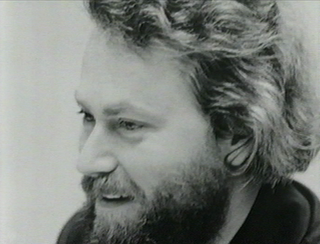
Donald Clarence Judd was an American artist associated with minimalism. In his work, Judd sought autonomy and clarity for the constructed object and the space created by it, ultimately achieving a rigorously democratic presentation without compositional hierarchy. He is generally considered the leading international exponent of "minimalism", and its most important theoretician through such writings as "Specific Objects" (1964). Judd voiced his unorthodox perception of minimalism in Arts Yearbook 8, where he says, "The new three dimensional work doesn't constitute a movement, school, or style. The common aspects are too general and too little common to define a movement. The differences are greater than the similarities."

The Hirshhorn Museum and Sculpture Garden is an art museum beside the National Mall in Washington, D.C., United States. The museum was initially endowed during the 1960s with the permanent art collection of Joseph H. Hirshhorn. It was designed by architect Gordon Bunshaft and is part of the Smithsonian Institution. It was conceived as the United States' museum of contemporary and modern art and currently focuses its collection-building and exhibition-planning mainly on the post–World War II period, with particular emphasis on art made during the last 50 years.

Spoonbridge and Cherry is a sculptural fountain designed by Claes Oldenburg and Coosje van Bruggen. It was funded by a $500,000 donation from art collector Frederick R. Weisman and is permanently located in the Minneapolis Sculpture Garden. The piece was completed and installed in 1988 for the Sculpture Garden's opening and consists of a large cherry resting atop a large spoon partially straddling a small pond.

The Olympic Sculpture Park, created and operated by the Seattle Art Museum (SAM), is a public park with modern and contemporary sculpture in downtown Seattle, Washington, United States. The park, which opened January 20, 2007, consists of a 9-acre (36,000 m2) outdoor sculpture museum, an indoor pavilion, and a beach on Puget Sound. It is situated in Belltown at the northern end of the Central Waterfront and the southern end of Myrtle Edwards Park.
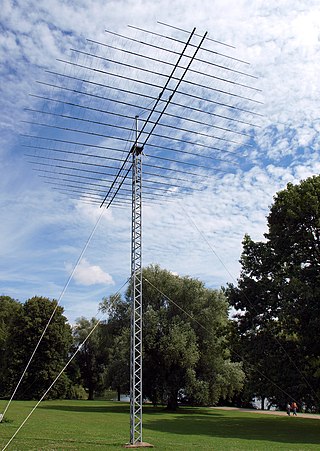
Skulptur Projekte Münster is an exhibition of sculptures in public places in the city of Münster (Germany). Held every ten years since 1977, the exhibition shows works of invited international artists for free in different locations all over town, thereby confronting art with public places. After every exhibition, the city buys a few of the exhibited sculptures which are then installed permanently.
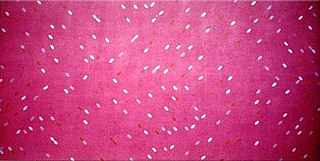
Lawrence M. "Larry" Poons is an American abstract painter. Poons was born in Tokyo, Japan, and studied from 1955 to 1957 at the New England Conservatory of Music, with the intent of becoming a professional musician. After seeing Barnett Newman's exhibition at French and Company in 1959, he gave up musical composition and enrolled at the School of the Museum of Fine Arts, Boston. He also studied at the Art Students League of New York. Poons taught at The Art Students League from 1966 to 1970 and currently teaches at the League.

Jeffrey Lynn Koons is an American artist recognized for his work dealing with popular culture and his sculptures depicting everyday objects, including balloon animals produced in stainless steel with mirror-finish surfaces. He lives and works in both New York City and his hometown of York, Pennsylvania. His works have sold for substantial sums, including at least two record auction prices for a work by a living artist: US$58.4 million for Balloon Dog (Orange) in 2013 and US$91.1 million for Rabbit in 2019.

Willard Park is a public park in downtown Cleveland, in the U.S. state of Ohio. The park sits at the northwest corner of East 9th Street and Lakeside Avenue, adjacent to Cleveland City Hall, and is within the boundaries of the Cleveland Mall historic district. It is the location of the public sculpture Free Stamp, and is the home of the original Cleveland Fire Fighters Memorial.

Claes Oldenburg was a Swedish-born American sculptor best known for his public art installations, typically featuring large replicas of everyday objects. Another theme in his work is soft sculpture versions of everyday objects. Many of his works were made in collaboration with his wife, Coosje van Bruggen, who died in 2009; they had been married for 32 years. Oldenburg lived and worked in New York City.
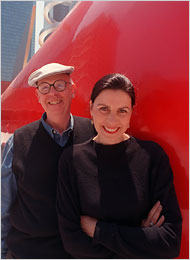
Coosje van Bruggen was a Dutch-born American sculptor, art historian, and critic. She collaborated extensively with her husband, Claes Oldenburg.
Giuseppe Panza di Biumo was a collector of modern art. He lived in Milan and Varese, Italy.

Banality is a series of sculptures by American artist Jeff Koons. The works were unveiled in 1988 and have become controversial for their use of copyrighted images. Several editions of the sculptures have sold at auction for millions of dollars.

Minimalism describes movements in various forms of art and design, especially Visual art and music, where the work is set out to expose the essence, essentials or identity of a subject through eliminating all non-essential forms, features or concepts. As a specific movement in the arts it is identified with developments in post–World War II Western Art, most strongly with American visual arts in the 1960s and early 1970s. Minimalism is often interpreted as a reaction to abstract expressionism and a bridge to postminimal art practices. Prominent artists associated with this movement include Ad Reinhardt, Nassos Daphnis, Tony Smith, Donald Judd, John McCracken, Agnes Martin, Dan Flavin, Robert Morris, Larry Bell, Anne Truitt, Yves Klein and Frank Stella. Artists themselves have sometimes reacted against the label due to the negative implication of the work being simplistic.

Modern sculpture is generally considered to have begun with the work of Auguste Rodin, who is seen as the progenitor of modern sculpture. While Rodin did not set out to rebel against the past, he created a new way of building his works. He "dissolved the hard outline of contemporary Neo-Greek academicism, and thereby created a vital synthesis of opacity and transparency, volume and void". Along with a few other artists in the late 19th century who experimented with new artistic visions in sculpture like Edgar Degas and Paul Gauguin, Rodin invented a radical new approach in the creation of sculpture. Modern sculpture, along with all modern art, "arose as part of Western society's attempt to come to terms with the urban, industrial and secular society that emerged during the nineteenth century".
Tau, by American sculptor Tony Smith, was designed in the early 1960s. It is 14’ high x 12’ wide x 12’ deep, and made from black painted steel. Its title refers to the Greek letter Τ (tau), which also describes the shape of the sculpture. Fascinated by mathematics, biology and crystals, Smith designed Tau with geometry at its root. There are two extant versions of the large sculpture: Tau (AP), and Tau (1/3).
Galerie Max Hetzler is a gallery for contemporary art with locations in Berlin, Paris and London.
Carlson Baker Arts is an American company that provides custom fabrication and engineering services to artists, architectural firms and commercial companies. Based in Sun Valley, California, the company is most known for its work for artists such as Ellsworth Kelly, Jeff Koons, Christian Moeller, Isamu Noguchi, and Claes Oldenburg / Coosje van Bruggen, among others. The firm was founded by Peter Carlson in 1971, and has been headed by Carlson and John Baker as partners since mid-2010. Fabricators like Carlson Baker assist in producing technically challenging, large-scale industrial, labor-intensive, or otherwise complex artworks beyond the capacities of artists and companies. Their technical services may range from 3D scanning and modeling to advanced machining, milling, and finishing to assembly, shipping, and installation.
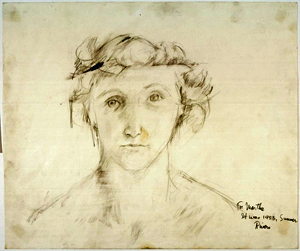
Martha Jackson was an American art dealer, gallery owner, and collector. Her New York City based Martha Jackson Gallery, founded in 1953, was groundbreaking in its representation of women and international artists, and in establishing the op art movement.
References
- 1 2 3 4 5 6 7 8 9 10 11 Michelle Kuo, "Industrial Revolution: The History of Fabrication," Artforum, August 2007. Accessed April 15, 2019.
- 1 2 3 4 Danielle Child, Working Aesthetics: Labour, Art and Capitalism, Bloomsbury Publishing, 2019. Accessed April 15, 2019.
- 1 2 3 4 Hass, Nancy "Are Art Fabricators the Most Important People in the Art World?" The New York Times, June 22, 2018. Retrieved April 5, 2019.
- 1 2 3 4 5 6 Scott Rothkopf, "Introduction," Artforum, August 2007. Accessed April 15, 2019.
- 1 2 3 4 5 6 7 Paul Young, "Those Fabulous Fabricators and Their Finish Fetish," L.A. Weekly, January 9, 2008. Accessed April 15, 2019.
- 1 2 Artforum, "The Producers: A Roundtable," Artforum, October 2007. Accessed April 15, 2019.
- 1 2 Lippincott, Jonathan D. (2010). Large Scale: Fabricating Sculpture in the 1960s and 1970s. New York, New York: Princeton Architectural Press. p. 256. ISBN 9781568989341.
- ↑ Peter Lunenfeld, "Art and Technology," Artforum, July 2015. Accessed April 15, 2019.
- ↑ Barry Newman, "Behind Some Great Artists Are the Skills of a Fabricator,", The Wall Street Journal, May 29, 2002. Accessed April 15, 2019.
- ↑ Jori Finkel, "At the Ready When Artists Think Big," The New York Times, April 27, 2008. Accessed April 15, 2019.
- ↑ "Carlson Baker Arts". carlsonbakerarts.com. Retrieved 2019-04-03.
- ↑ No Preservatives: Looking at LARGE SCALE; A Conversation with Jonathan Lippincott, Art21 Magazine, 15 Mar 2011, retrieved 26 Jan 2014
- ↑ Large Scale: Lippincott Inc., the Paris Review Daily, 7 Dec 2010, retrieved 26 Jan 2014
- ↑ "Standard Sculpture LLC". standardsculpture.com. Retrieved 2017-02-08.
- ↑ Barber, Lynn (May 2001). "Some day, my plinth will come". The Guardian Observer. Retrieved August 13, 2013.
- ↑ Amaral Custom Fabrication , retrieved 28 April 2014